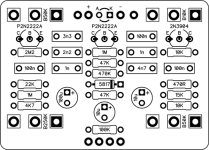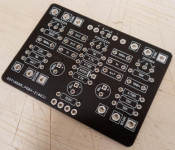ColorMeBaddFann
Member
Hello All - Finished up the Depot Fuzz last night. Plugged it in and getting a bypass signal, but when engaging the footswitch I receive a barely there fuzz effect that's very muffled and sort of "blown out" sounding. Definitely does not sound like the EQD Terminal demos I've seen.
Read through all of the troubleshooting threads I could find on this PCB, and I think I've accounted for most of the issues mentioned there... confirmed I have the correct pinout for transistors (tried both PN2222As and 2N2222As for Q1 & Q2... does not appear to be any difference), socketed C3 to try out 4n7 vs 47n, cleaned up the board with isopropyl, offboard wiring looks correct... still same result.
My guess is that I may have mixed up some of the resistor values between the build doc versions (purchased PCB in Feb '22). Does that sound like a possibility based on the symptoms?
Hoping someone could post a photo of the PCB with the silkscreen values. The build doc version currently listed on the Depot Fuzz product page (v1.95 - May '22) component identifiers on the PCB illustration does not match the photo on the product page. And neither have the values like the silkscreen does.
Thanks!
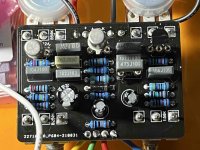
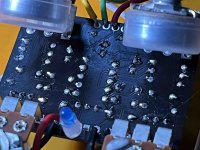
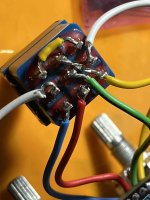
Read through all of the troubleshooting threads I could find on this PCB, and I think I've accounted for most of the issues mentioned there... confirmed I have the correct pinout for transistors (tried both PN2222As and 2N2222As for Q1 & Q2... does not appear to be any difference), socketed C3 to try out 4n7 vs 47n, cleaned up the board with isopropyl, offboard wiring looks correct... still same result.
My guess is that I may have mixed up some of the resistor values between the build doc versions (purchased PCB in Feb '22). Does that sound like a possibility based on the symptoms?
Hoping someone could post a photo of the PCB with the silkscreen values. The build doc version currently listed on the Depot Fuzz product page (v1.95 - May '22) component identifiers on the PCB illustration does not match the photo on the product page. And neither have the values like the silkscreen does.
Thanks!






